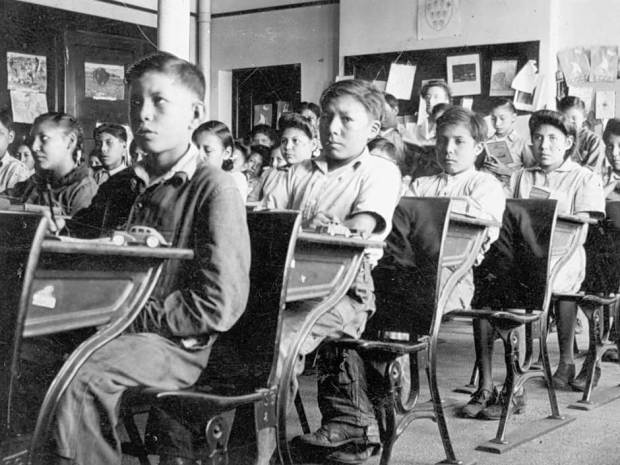|
Residential Schools and Governmental Failure |
|
A recent commission on Canada’s residential schools for aboriginal
people revealed that this school system originated in the 19th
century. During that period, the prevailing sentiment held that
government “was ordained by God” and that its institutions were
infallible and omniscient. It was believed that truth would result from
adversity through academic debate in the nation’s elected parliament and
in its courts. The notion that government institutions that sought
expert guidance from leading academics and church leaders could commit
grievous errors was dismissed as ridiculous.
 In his treatise entitled Education – Free and Compulsory, author
Murray Rothbard wrote that during the latter part of the 19th
century, the Kaiser of Prussia regarded children as rightfully being the
property of the state and believed that it was the duty of the state to
educate them into becoming loyal and productive citizens. Compulsory
schooling began in Prussia, and many governments around the world
subsequently embraced the ideal of compulsory attendance in state
schools, where the nation’s children would acquire the basic knowledge
they needed to become productive citizens. In his treatise entitled Education – Free and Compulsory, author
Murray Rothbard wrote that during the latter part of the 19th
century, the Kaiser of Prussia regarded children as rightfully being the
property of the state and believed that it was the duty of the state to
educate them into becoming loyal and productive citizens. Compulsory
schooling began in Prussia, and many governments around the world
subsequently embraced the ideal of compulsory attendance in state
schools, where the nation’s children would acquire the basic knowledge
they needed to become productive citizens.
The idea of compulsory schooling took hold in Canada as well, and
government officials and church leaders regarded it as their sacred duty
to convert aboriginal children into loyal subjects of the Crown and have
them embrace Christianity. Government officials forcibly removed
thousands of young children from their families and made them wards of
the Crown who were to be housed and educated in residential schools.
The elite of British society paid tuition to private boarding schools
that provided an education to boys beginning at the age of six. During
the school term, students attending these institutions had minimal or no
contact with their families. Discipline included corporal punishment. In
his memoirs, Winston Churchill, who had attended a private boarding
school, recalled the school nurse having to attend to students’ bleeding
buttocks after they had been caned. Colonial era government officials,
bureaucrats, and church officials likely regarded private British
boarding schools as the ideal model for Canadian residential schools
aimed at educating First Nations children.
|
|
“The abuse of children that
occurred at Canadian residential schools are the result of
once well-intended government policies that were based on
very flawed ideas.” |
|
In Canada, government and church officials regarded First
Nations people as savages, hence the brutal treatment of
native children at residential schools. Both German and
British colonial administrations shared a common sense of
contempt toward aboriginal populations, which were often
subject to inhumane treatment. During the years of colonial
rule, the native East Indian population had suffered through
successive episodes of famine that were the direct result of
the colonial administration’s actions. During India’s
colonial era, several million Indians starved during
repeated famines caused by policies administered and
enforced by the colonial office.
The majority of colonial era bureaucrats were educated in
the arts and the social sciences at universities where the
leading academics were sympathetic to the theory of eugenics
that held that people with dark skin were inferior to people
of British and European origins. That sentiment guided the
development of social and economic policies that related to
native peoples who lived under colonial rule. It would also
have guided the government policy that forcibly removed
young children from native Canadian families and placed them
in residential schools.
While the short-term objective may have had noble
intentions, from a certain perspective, the long-term
results included the emotional and spiritual destruction of
hundreds of lives spread over successive generations of
Canada’s First Nations people. Prior to WWII, the Government
of Germany introduced its own version of residential schools
for “pure Aryan” children, beginning during infancy. The
state employed nurses and other professional staff to raise
and educate these favoured children in a so-called ideal
environment. But the long-term result was very different
from the short-term objective, as older children from the
program required extensive psychoanalytic therapy.
The abuse of children that occurred at Canadian residential
schools are the result of once well-intended government
policies that were based on very flawed ideas. One key idea
involves the appropriateness of government initiating
forcible coercion against peaceful citizens, allegedly for
the benefit of society. The abuse is obvious, blatant and
obscene.
Another, less dramatic example is compulsory school
attendance for all Canadian children at schools where they
are at high risk of being bullied by peers and where they
are required to learn at the pace set by the institution,
totally disregarding each child’s own unique learning style.
In education, home-schooled children almost consistently
out-achieve their cohorts who attend state schools, in
academic contests. In modern government schools, the
destruction of people’s lives is more subtle and more
discrete than the obscenity that occurred at residential
schools, but it is no less real.
|
|
|
From the same author |
|
▪
Ontario Sex-Ed Curriculum Protests & Government
Infallibility
(no
332 – May 15, 2015)
▪
Water as State Property
(no
332 – May 15, 2015)
▪
Free Market Trade and Border Towns
(no
330 – March 15, 2015)
▪
Growing Concerns about Sexual Violence on Campus
(no
329 – February 15, 2015)
▪
Alberta Challenges Home-Schooling Families
(no
329 – February 15, 2015)
▪
More...
|
 |
|
First written appearance of the
word 'liberty,' circa 2300 B.C. |
|
Le Québécois Libre
Promoting individual liberty, free markets and voluntary
cooperation since 1998.
|
|

